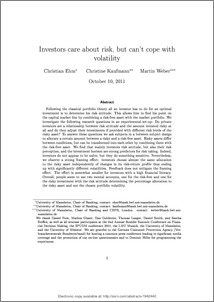|
Investors care about risk, but can't cope with volatility
Ehm, Christian
;
Kaufmann, Christine
;
Weber, Martin
![[img]](https://madoc.bib.uni-mannheim.de/style/images/fileicons/application_pdf.png)  Vorschau |
|
PDF
SSRN-id1942440_WP179.pdf
- Veröffentlichte Version
Download (421kB)
|
|
URL:
|
https://ub-madoc.bib.uni-mannheim.de/31452
|
|
Weitere URL:
|
http://dx.doi.org/10.2139/ssrn.1942440
|
|
URN:
|
urn:nbn:de:bsz:180-madoc-314529
|
|
Dokumenttyp:
|
Arbeitspapier
|
|
Erscheinungsjahr:
|
2011
|
|
Titel einer Zeitschrift oder einer Reihe:
|
Working Paper / Lehrstuhl für Finanzierung, Universität Mannheim
|
|
Band/Volume:
|
179
|
|
Ort der Veröffentlichung:
|
Mannheim
|
|
Sprache der Veröffentlichung:
|
Englisch
|
|
Einrichtung:
|
Fakultät für Betriebswirtschaftslehre > ABWL u. Finanzwirtschaft, insbes. Bankbetriebslehre (Weber 1993-2017)
|
|
MADOC-Schriftenreihe:
|
Lehrstuhl für ABWL, Finanzwirtschaft, insb. Bankbetriebslehre (Weber) > Working Papers
|
|
Fachgebiet:
|
330 Wirtschaft
|
|
Fachklassifikation:
|
JEL:
G11,
|
|
Freie Schlagwörter (Englisch):
|
portfolio choice , portfolio selection , risk-taking , volatility , naive diversification , framing
|
|
Abstract:
|
Following the classical portfolio theory all an investor has to do for an optimal investment is to determine his risk attitude. This allows him to find his point on the capital market line by combining a risk-free asset with the market portfolio. We investigate the following research questions in an experimental set-up: Do private investors see a relationship between risk attitude and the amount invested risky at all and do they adjust their investments if provided with different risk levels of the risky asset? To answer these questions we ask subjects in a between subject design to allocate a certain amount between a risky and a risk-free asset. Risky assets differ between conditions, but can be transformed into each other by combining them with the risk-free asset. We find that mainly investors risk attitude, but also their risk perception, and the investment horizon are strong predictors for risk taking. Indeed, investors do not appear to be naïve, but they do something sensitive. Nevertheless, we observe a strong framing effect: investors choose almost the same allocation to the risky asset independently of changes in its risk-return profile thus ending up with significantly different volatilities. Feedback does not mitigate the framing effect. The effect is somewhat smaller for investors with a high financial literacy. Overall, people seem to use two mental accounts, one for the risk-free and one for the risky investment with the risk attitude determining the percentage allocation to the risky asset and not the chosen portfolio volatility.
|
 | Dieser Eintrag ist Teil der Universitätsbibliographie. |
 | Das Dokument wird vom Publikationsserver der Universitätsbibliothek Mannheim bereitgestellt. |
 Suche Autoren in Suche Autoren in
Sie haben einen Fehler gefunden? Teilen Sie uns Ihren Korrekturwunsch bitte hier mit: E-Mail
Actions (login required)
 |
Eintrag anzeigen |
|
|
 ORCID: 0000-0001-5018-3317
ORCID: 0000-0001-5018-3317



 Suche Autoren in
Suche Autoren in